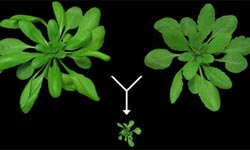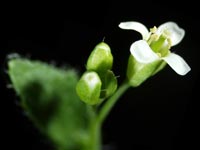This article is reposted from the old Wordpress incarnation of Not Exactly Rocket Science.
![]() "Congratulations, it's a stunted, malformed, necrotic hybrid!" Those aren't really the words that new parents want to hear but thankfully, plants aren't in a position to be that upset.
"Congratulations, it's a stunted, malformed, necrotic hybrid!" Those aren't really the words that new parents want to hear but thankfully, plants aren't in a position to be that upset.
 In several species of plants, a surprising number of offspring turn out to be malformed hybrids that quickly wither and die. Now, Kirsten Bomblies and colleagues from the Max Planck Institute for Developmental Biology have found out why.
In several species of plants, a surprising number of offspring turn out to be malformed hybrids that quickly wither and die. Now, Kirsten Bomblies and colleagues from the Max Planck Institute for Developmental Biology have found out why.
Two genes, one passed down by each parent, ignite an reaction in the hybrid youngster that turns its immune system against it. It's not a genetic disorder; neither gene was faulty and both were harmless in their native parental environments. But they evolved apart from each other and make poor bedfellows when united.
They behave like employees from two merging companies. Having developed in different backgrounds and working cultures, they can find it difficult to work together, lowering the productivity of the new business.
Over time, these incompatibilities could drive wedges between different plant strains, reducing their chances of successful mating and turning separate strains into separate species.
These genetic clashes that Bomblies found were predicted several decades earlier by two giants of modern genetics, Theodoris Dobzhansky and Hermann Muller. They suggested that different species fail to mate successfully because their unison causes genes that were innocuous in the parents to interact in unforeseen and harmful ways. Today, these genetic clashes bear the somewhat unwieldy name of their imaginers - Dobzhansky-Muller incompatibilities.
Last year, another group found two such incompatible genes in the hybrid spawn of two closely related species of fruit fly. Both genes had rapidly evolved since the two species split from each other, suggesting that these incompatibilities are a necessary evil that result from otherwise beneficial adaptations.
As Dobzhansky and Muller predicted, these genetic conflicts serve to keep species apart, but Bomblies's research suggests that it keeps them separate in the first place.
 Her team initially set out to study a particularly deadly form of genetic incompatibility called hybrid necrosis. The affected plants live short and troubled lives, plagued by stunted growth and yellow, warped and withered leaves.
Her team initially set out to study a particularly deadly form of genetic incompatibility called hybrid necrosis. The affected plants live short and troubled lives, plagued by stunted growth and yellow, warped and withered leaves.
Bomblies noticed that the symptoms of hybrid necrosis were always the same, even in very diverse groups of plants. She reasoned that the underlying processes must also be similar and set out to study the genetics behind the condition. And when scientists want to study plant genetics, there's only one real plant-of-choice - Arabidopsis thaliana, the thale cress.
Bomblies crossed 280 genetically distinct strains of Arabidopsis in 861 different ways and found that 2 per cent of the resulting hybrids were necrotic. As well as sharing the same symptoms, these unlucky 20 plants also shared a similar portfolio of genetic activity in a group of 1,080 genes.
All of the genes that were more strongly activated were involved in immune responses to infection. If the plants were actually infected, these genes would have saved their lives. Unfortunately, there were no marauding germs - the hybrids were being attacked by their own immune systems. These 'autoimmune responses' explains why the symptoms of hybrid necrosis look very much like those of a fatal disease.
In most cases, Bomblies found that only two genes were needed to cause the autoimmune response, although these differed from case to case.
When she looked at one hybrid in greater detail, she found that one of the two genes belonged to the NB-LRR class, a common group of disease resistance genes involved in recognising new infections. When Bomblies switched off the problematic gene, the hybrids developed normally.
 Bomblies suggests that the NB-LRR gene needs its dance partner to sense potential threats. When this works, the duo trigger localised patches of cell death at the point of infection, effectively stopping invaders from spreading to other parts of the plant.
Bomblies suggests that the NB-LRR gene needs its dance partner to sense potential threats. When this works, the duo trigger localised patches of cell death at the point of infection, effectively stopping invaders from spreading to other parts of the plant.
But if the dance partners are incompatible, their missteps trigger an extreme version of this defence where the plant's own cells are recognised as intruders and attacked. The result is large-scale tissue death - hybrid necrosis.
Bomblies believes that similar events take place in the other necrotic Arabidopsis hybrids, and indeed in other reported cases of hybrid necrosis in tobacco and tomato plants. Conflict between incompatible immune genes could be a commonplace occurrence in the plant world, and it adds a new dimension to the concept of species.
Traditionally, living things are classified as different species if they cannot produce fertile offspring. In this definition, species are like separate streams of genetic information, prevented from mixing by large barriers.
But Bomblies' work suggests that these barriers already exist within individual species. Because of immune conflicts, some individuals would struggle to produce fertile offspring - in effect, the streams are actually multiple currents separated by rising islands.
For plants at least, the rise of new species may be an inevitable consequence of the evolutionary arms race between plants and their infections. The same new weapons that give their immune system an adaptive edge over disease-causing invaders can also serve to drive genetic wedges between different lineages.
The same thing may apply to animals too. Some human couples find it difficult to conceive children together but succeed with different partners. Could their failed eggs fail because of autoimmune reactions, the human equivalent of a necrotic Arabidopsis? It's an intriguing idea, and one that deserves further research
Reference: Bomblies, Lempe, Epple, Warthmann, Lanz, Dangl & Weigel. 2007. Autoimmune response as a mechanism for a Dobhansky-Muller-Type incompatibility syndrome in plants. PLoS Biol 5: e236 doi:10.1371/journal.pbio.0050236




What about cases of increased fertility over the average? Could there be something that makes certain couples more compatible (genetically speaking only) than the "average" partner? I mention this because my parents had difficulty conceiving, and so did my in-laws, but my wife and I have found that the old joke that some women will get pregnant from their spouse "breathing" on them appears true in our case.
As noted last year, this might be relevant:
http://notexactlyrocketscience.wordpress.com/2008/02/13/third-cousin-co…